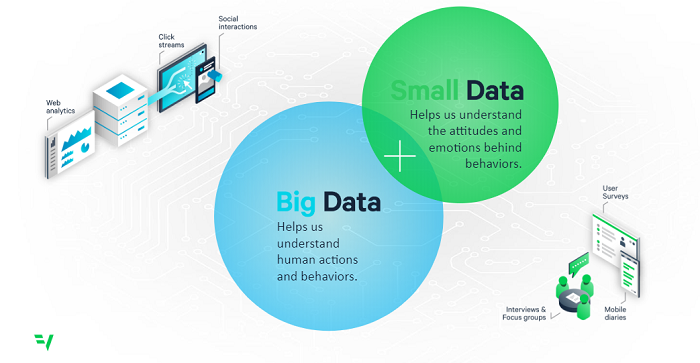Companies are under more pressure than ever to build out effective, profitable customer experience projects, especially as expectations across various industries continue to become more and more nuanced. Most brands agree that understanding customers is important. Yet, only 38% claim to know why one customer chooses to engage with their products or services while another doesn’t. That said, those companies that leave no stone unturned to understand their customers holistically, are more likely to have successful businesses.
Marketers and researchers must tap into how customers think and feel by integrating small data – data from research fielded via surveys, focus groups, and qualitative interviews, for example – with big data, which helps us understand actions and behaviors through the analysis of things like clickstream and social interaction data. This helps brands truly understand the “why” behind how customers think and feel, and executing it is truly the differentiating factor for allowing brands a better chance of understanding customer sentiment. Allow me to expand on three of the fundamental benefits of utilizing small data below:

Small data provides insights that help drive sales
The customer sentiments that small data findings uncover give marketers the unique ability to observe whether changes to their products or services have a positive or negative effect on customer experience. Such insights are invaluable, considering that understanding how a customer thinks and feels about a brand or product has a 1.5x greater impact on driving sales. Small data is key for brands wanting to understand their strongest value propositions, an understanding which empowers them to make decisions that result in favorable business outcomes.
Small data enables the successful launch of new products and services
The companies that believe their CX strategies to be effective because of small data integration are more likely to enjoy business improvements beyond customer satisfaction and retention, including the successful debut of new products and services. For instance, after utilizing small data to understand why their product was losing market share despite high demand, Pampers®, Procter & Gamble’s largest brand, managed to carry out adjusted diaper sizes and re-designed packaging that improved shelf visibility. In today’s environment, products and services with distinguished qualities can easily be duplicated by competing brands, contributing to a sharp surge in customer expectations. As a result, positive customer experiences have become a key competitive differentiator for companies, alongside a strategic imperative.
Small data ensures steady day-to-day operations
Expert marketers and stakeholders who have been relentless in ensuring that the use of small data to support big data is a process that gets embedded into day-to-day operations have become internally better informed of the strategic direction of their brands. While fostering a culture where this is customary may require change, data is only going to multiply, and mastering the use of it is pivotal for establishing effective customer experience.
Both marketing and research teams need to be willing to adopt data management systems that can sift through the data available to them and that integrate and harmonize big and small data sets. They also need to ensure that all other departments are on board with the process and willing to collaborate cross-departmentally. The latter is especially true regarding support from C-suite executives and other stakeholders, whose opinions have major influence throughout an organization. As long as companies are willing to deviate from their outdated ways, they too can reap the aforementioned benefits of including small data.
Companies that do not attempt to fill the knowledge gap between CX success and application caused by a lack of the integration of big and small data will ultimately fail. Big data can tell companies at a broad, timely level what their customers are doing, but only small data can disclose why they are doing it. Together, the two are a dynamic force for brands wanting to implement CX projects at the highest level.
About the Author

Zoe Dowling, Ph.D. is FocusVision’s SVP of research. With a background across industries, she has concentrated on the online world since the 1990s. She specializes in respondent engagement for web and mobile surveys, and qualitative approaches related to online communities and interview techniques. She is a regular speaker on topics relating to consumer insights, new technologies and storytelling.
Sign up for the free insideAI News newsletter.





Speak Your Mind